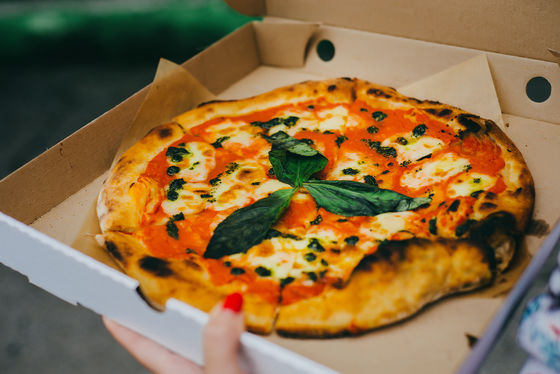'Rule of 2 pizzas' that Amazon succeeded in expanding the company infinitely

Amazon is now a big company in the world, but in the early days, its founder Jeff Bezos enacted a rule. The rule is that ' all teams in the company must be the right size to eat two pizzas .' The Guardian introduces this 'two pizza rule' as supporting Amazon's infinite growth.
The two-pizza rule and the secret of Amazon's success | Technology | The Guardian

The 'two pizza rule' is a rule that was created with an emphasis on efficiency and scalability . In terms of efficiency, smaller teams can reduce wasted time from 'ease of time management' and keep members on the team up-to-date. However, it seems that the latter 'scalability' is a really important factor for Amazon.
Benedict Evans, an analyst at venture capital firm Andreessen Horowitz, said of the benefits of Amazon's 'two-pizza rule' being driven by a small team: 'When you add a new product line, you have a new internal structure. You don't have to build or submit reports directly, let alone meet with departments, start up projects (for new product lines), develop complex business plans, or prepare new electronic commerce platforms. You don't even have to You don't even have to create a roadmap to do that. '

by Alexandra Gorn
It's clear that Amazon is an e-commerce company that sells goods, but at the same time, it is also good at 'creating an e-commerce company that sells new things.' Amazon calls the ' flywheel ' approach to 'creating an e-commerce company that sells new things.'
The best example of this flywheel is the birth and growth of 'AWS'. AWS is a company and service that provides cloud computing services to Amazon and other companies. On AWS, like Amazon, all teams designated by CEO Bezos must work together using only structured and systematic methods. For example, if your advertising team needs data about shoe sales, you can't send an email to the analytics department asking for 'best use of resources.' Instead, you can get the data yourself from the dashboard for data analysis, and if that dashboard doesn't exist, you'll need to create one. With this approach, which can be said to be one of the benefits of the two-pizza pizza rule, various services have grown and become huge, which is the company called Amazon.
The technology that Amazon created to share resources within the organization may be offered to other companies as is. One such service is AWS, which has grown to account for 10% of Amazon's total revenue. In the fourth quarter of 2017, when Amazon recorded record profits and sales, AWS recorded revenue of $ 5.11 billion (about 559 billion yen), up 44.6% from the previous year. In addition, Amazon lists three top-level financial divisions, 'America and Canada', 'International', and 'AWS', and you can see how AWS has grown into a huge service that supports Amazon as a whole. ..
Amazon records record high final profit and sales, announcement of financial results for the fourth quarter of 2017 --GIGAZINE

With revenues as high as Amazon's sales around the world, Netflix, which accounts for about one-third of North American Internet traffic, has so many customers. In order to efficiently move a large amount of data to AWS cloud services, Amazon has even developed a dedicated track 'Snowmobile', and for companies that want to upload a large amount of data to AWS, this snowmobile It seems that it may be dispatched.
'AWS Snowmobile' that efficiently transfers exabyte-class data to AWS --GIGAZINE

The second flywheel with different characteristics from AWS is the 'Amazon Marketplace'. This is a service that started in 2000 and allows third-party sellers to sell their products on Amazon. The service has been expanding for years, and it's clear that it's a big force for Amazon, which aims to be a 'destination on the Internet to buy everything that exists.' The Guardian also notes that the advantage of Amazon Marketplace is that it can expand Amazon without increasing the number of employees, and in a sense it is 'better than the two-pizza rule.' I am.
Amazon reports that the revenue it earns from the marketplace is about 20% of the company's total revenue. This is a simple calculation based on commissions paid to Amazon by third-party sellers: 'Now, the number of products sold on the marketplace accounts for half of the total number of products sold on Amazon. 'Evans points out.
In the world of the Amazon market where AI moves the price of goods up and down, the price fluctuates like the stock market --GIGAZINE

And the third flywheel that Amazon has been focusing on since 2014 is to incorporate artificial intelligence (AI) into its business. Even before that, Amazon was at the forefront of the AI industry and adopted recommended algorithms using neural networks for its services. However, since Amazon began developing the smart speaker Amazon Echo and the AI voice recognition assistant Alexa, the relationship between AI and Amazon will deepen.
Economies of scale for AI are unique. The data is valuable, and the more people who use Amazon Echo, the more audio samples for AI learning, and the better the quality of Alexa and Amazon Echo. In addition, the machine learning technology that underpins Alexa is so versatile that as the number of Amazon Echo users increases, all of Amazon's businesses will advance and become more efficient, opening up new fields and providing further research tools. You will also be able to make suggestions, The Guardian said.
Amazon's voice recognition 'Alexa' is sweeping the world's IoT and is becoming the champion of the 'next to smartphone' platform-GIGAZINE

Of course, nothing lasts forever, and Amazon has its weaknesses. For example, the two-pizza rule is a good strategy for building an infinitely extensible company, but not for building a stress-free and comfortable environment, and Amazon is long as if to symbolize this. It has been criticized for being treated as a warehouse worker.
What is the 'harsh working environment' that a reporter who worked in an Amazon warehouse hiding his identity talks about? --GIGAZINE

Related Posts:
in Note, Web Service, Posted by logu_ii







